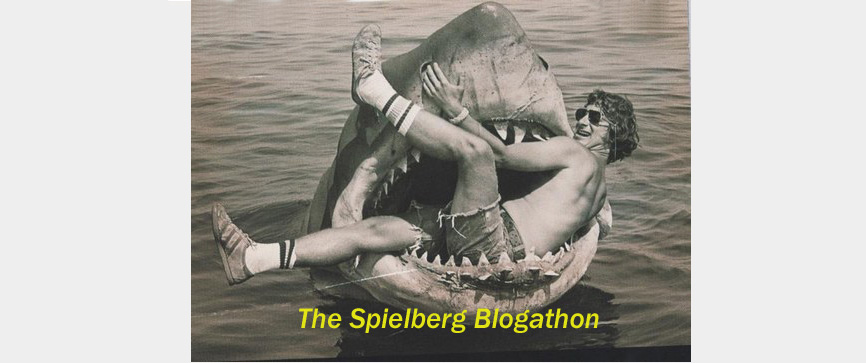
Saving Private Ryan (1998): What Is Happening?
by Adam Zanzie
I think Samuel Fuller is really the only filmmaker, out of all the filmmakers Rosenbaum mentioned in his review, who had a significant influence on Saving Private Ryan. Fuller and Spielberg were evidently good friends during Fuller’s lifetime (Spielberg had cast Fuller as the Interceptor Command officer in 1941), and, thus, Fuller’s influence is already present in a handful of Spielberg’s later films: Short Round in Temple of Doom, for example, was named after the kid from The Steel Helmet; and, in Minority Report, a violent scene from House of Bamboo is playing on television during the sequence in which Anderton’s eyes are taken out. Saving Private Ryan, thus, has a lot of scenes that reek of the influence of scenes from Fuller’s own war films. From The Steel Helmet, Spielberg recycles a scene in which GIs shoot in all directions at a sniper hiding in an elevated area, as well as a scene in which GIs contemplate executing an enemy POW. From The Big Red One, Spielberg recycles the device of a soldier who starts out a pacifist and ends up a cold-blooded killer by the end (Jeremy Davies’ Upham = Mark Hamill’s Griff). And you can tell that Spielberg probably watched the D-Day sequence in The Big Red One dozens of times before heading off to shoot the D-Day sequence for his own film.
The Great Schism: Spielberg As A Villain
by Elliot Gallion
The movies to which Steven Spielberg has as-of-late lent his name and capital, both creative and financial, are detrimental to the art form. I do not want another Transformers movie from EXECUTIVE PRODUCER STEVEN SPIELBERG. I do not wish to see a $250 million movie based on an idea that could have been pitched by a producer of daytime cartoons from EXECUTIVE PRODUCER STEVEN SPIELBERG. I do not wish to see another Indiana Jones movie. I do not wish to have my local multiplex polluted with the likes of a full-length feature film that consists entirely of digital motion capture. I do not wish to see movies with more people filtered through computers than people with organs in their bodies whose sadness and humor are actually alive. I do not care if “anything is possible”; the harvest at the end of the frontier has so far yielded little crop. I want to see movies about people living in the world. By my assessment, Steven Spielberg—either through his own work or by his support of others—has abandoned that basic precept.
Duel (1971)
by Chris Zafeiriadis
The film features a one and only central character, on the road for a business trip. He travels alone in an almost deserted highway, and during that trip, and without either wanting it or having sought it, he finds himself in a race of survival (“everybody runs”), face to face with a mammoth dirty truck. A giant road shark, who seems to be the ultimate-born baddy, terrifies and attacks his victim without obvious motivation. All right... the last bit was a bit too easy, so I take it back without wanting to push further the obvious reference to that other glorious movie.
The Color Purple (1985)
by Jake Cole
Alice Walker initially questioned the choice of Spielberg as director, a fair objection considering the entire point of the novel is that men (and specifically white men) run the world. Walker relented when she saw E.T. and considered the director's portrayal of the alien and the abuse it suffered as that of an ethnic minority. However, Spielberg's thematic concerns make him a surprisingly easy choice for the film: his own history of father issues translates well to a larger critique of masculinity, while his earnest, if naïve, sentimentality ensures that he tries his best to break down racial barriers.
Encountering Spielberg: A Steven Spielberg Profile (Part 3)
by Trevor Hogg
“I’ve always found that science speculation was about the preternatural,” observed Spielberg. “It is more or less what the name implies. It’s elements of nature that we know exist; we’re just not sure how they exist or how to measure their existence. But they’re things that we know are around us in everyday waking life. Science fiction, of course, is just boundless. It’s to the limits of one’s imagination. And so far it hasn’t been discovered where those limits reside.” Teaming with directors John Landis (An American Werewolf in London), Joe Dante (Gremlins), and George Miller (Babe), Steven Spielberg recreated two classic episodes and produced two original stories inspired by a classic Rod Serling television series for Twilight Zone: The Movie (1983). The director was responsible for the second segment called Kick the Can where a group of seniors in a retirement home play the game of kick the can which transforms them back to their childhood selves. Production on the project was seriously marred when a fatal helicopter crash occurred during the filming of John Landis’ portion which led to the deaths of veteran performer Vic Morrow (The Bad News Bears) and two child actors.
Man vs. Machine
by Joel Bocko
A visual tribute to Duel.

No comments:
Post a Comment
Note: Only a member of this blog may post a comment.